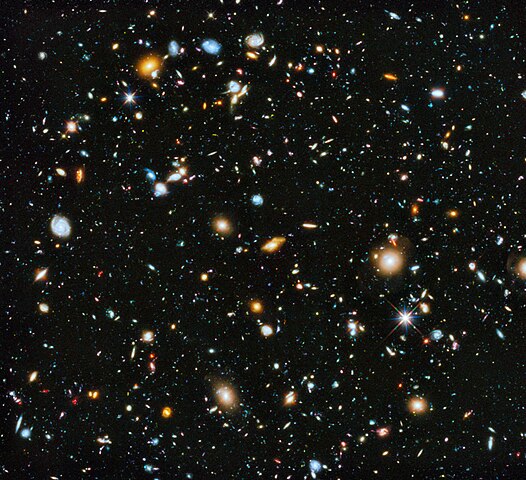5. The Cosmic Web
Summary The observable Universe has a radius of about 46 billion light-years and contains at least a trillion galaxies. Due to the existence of dark energy it expands at an accelerating rate since about 4 billion years. The galaxies form a web-like structure, called the Cosmic Web, with filaments and walls consisting of galaxies and nearly empty voids in between.
Keywords Dark Energy; Galaxies; Galaxy Groups and Clusters

The Hubble Ultra-Deep Field, an image of numerous early galaxies close to the edge of the observable Universe. The data for this image was taken by the Hubble Space Telescope during several exposures between 2003 and 2012. (© NASA, ESA, H. Teplitz and M. Rafelski (IPAC/Caltech), A. Koekemoer (STScI), R. Windhorst (Arizona State University), and Z. Levay (STScI) / Wikimedia Commons / Public Domain)
Today the radius of the observable Universe is about 46 billion light-years. This is larger than the distance which light travels in 13.8 billion years, the age of the Universe since the Big Bang, which is due to the expansion of space itself during the light was travelling. The actual Universe is thought to be larger than the observable Universe, however no light or information from more distant regions reached Earth yet. In the observable Universe there are at least a trillion (1012) galaxies with many more stars.
While the light of these distant galaxies is reaching us now, they actually evolved in the meantime – that means in the last 13.8 billion years – and should look very different now. Thus, when astronomers look into distant regions of the Universe, due to the finite speed of light they actually look into the distant past of these regions. This principle can also be applied to other more earthly situations: For example, from Earth we can only see the past of the Sun of about eight minutes ago, and you are likely only seeing this sentence on the past of the screen in front of you of about a billionth of a second (10-9 s) ago. In the latter example, however, the delay of a billionth of a second is not critical in our daily lives as the human reaction time of about the tenth of a second is much longer.
By the study of distant star explosions in 1998 it became clear that the Universe is expanding at an accelerating rate since about 4 billion years, that means since the time when the Universe was about 10 billion years old. This accelerating expansion is attributed to dark energy, a not well understood energy which is repulsive, thought to be a property of space itself and which is constituting the largest fraction of the total energy in the current Universe.
Galaxies are not evenly distributed in the Universe but accumulate at certain positions. While collections of up to around 50 galaxies are called galaxy groups, collections with more galaxies are called galaxy clusters. Galaxy groups and clusters form even bigger structures, called galaxy superclusters, which form the Cosmic Web, the first glances on which were achieved in the late 1980s. The Cosmic Web is made up of mainly one-dimensional galaxy filaments and mainly two-dimensional galaxy walls, made up of galaxy clusters, galaxy groups and single galaxies, and which form the shells of nearly empty bubble-like voids. The latter ones are also called Hubble bubbles and fill about 80% of space. On a bigger length scale of billions of light-years, however, the distribution of galaxies in the Universe appears to be mostly homogeneous.

A visualization of galaxy superclusters in our vicinity. We are located in the Virgo Supercluster, displayed in red font. (© Andrew Z. Colvin / Wikimedia Commons / CC-BY-SA-3.0)
The Local Group of galaxies, with a size of 10 million light-years and containing around 50 galaxies, is located in the larger Laniakea Supercluster of galaxies, with a size of more than 500 million light-years and containing around 100,000 galaxies. The Laniakea Supercluster was defined in 2014 and contains the Virgo Supercluster in which we are located, the Hydra-Centaurus Supercluster and the Pavo-Indus Supercluster. It is centered around the Great Attractor, which is a dense region at a distance of around 250 million light-years to which the sight is obstructed by the center of the Milky Way, our host galaxy. Even though it can not be directly seen, the presence of the Great Attractor was still shown by measuring the speeds of surrounding galaxies which reveal its gravitational attraction. While galaxy clusters and groups are gravitationally bound objects, galaxy superclusters in general and the Laniakea Supercluster in particular are not gravitationally bound. While galaxy superclusters constitute dense regions in the Universe today, their constituting galaxy clusters and groups will be pulled away from each other due to the continuing expansion of the Universe.
